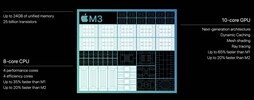Apple A8 vs Apple M3
Apple A8
► remove from comparison
The Apple A8 is a high-end ARM SoC (System on a Chip) launched in September 2014 alongside the iPhone 6 and iPhone 6 Plus. The two CPU cores are clocked at 1.4 GHz (compared to the 1.3 GHz Apple A7) and are based on Apple's 2nd generation 64-bit architecture, called "Cyclone 2". Furthermore, the A8 integrates a PowerVR Series 6 (Rogue) GX6450 GPU and a 2x 32-bit LPDDR3-1333 memory controller.
Architecture
With Cyclone 2, Apple have managed to improve the already high performance per clock of the original Cyclone core (Apple A7) by another 10 to 15 percent. Neither Qualcomm's Krait nor ARM's Cortex-A57 can compete with the resulting IPC. The exact design changes have not been revealed, but we would expect enlarged caches and registers as well as an optimized branch prediction. As an ARMv8 architecture, Cyclone 2 is 64-bit capable.
Performance
Thanks to its impressive performance per clock, the Apple 1.4 GHz dual-core is a tough opponent for other high-end SoCs like the Nvidia Tegra K1 (4 cores @ 2.3 GHz) or Qualcomm Snapdragon 805 (4 cores @ 2.7 GHz). While the quad-core competitors win most multi-threaded benchmarks, the Apple A8 offers superior single-threaded performance, which is arguably more relevant for most everyday tasks like browsing. Overall, the A8 is one of the fastest smartphone SoCs as of late 2014.
Graphics
The SoC integrates a PowerVR Series 6 (Rogue) GX6450 GPU consisting of 4 clusters. Each cluster offers four FP16 and two FP32 ALUs, leading to a slightly higher shader performance than the former G6430. The core is predicted to be clocked relatively low at around 450 MHz (115 GFLOPS) to help reduce power consumption. According to our benchmarks, the GX6450 clearly outclasses the Adreno 330 in terms of 3D performance, but looses against Nvidia's more power hungry Tegra K1. Thus, the GX6450 is one of the fastest smartphone GPUs as of 2014 and can handle even the most demanding mobile games in high resolutions.
Power Consumption
In contrast to previous Apple SoCs, the A8 is manufactured by TSMC instead of Samsung. Using a brand-new 20 nm process, the SoC measures just 89 mm² and consists of about 2 billion transistors. Power consumption should be similar to or slightly below competing high-end SoCs by Qualcomm or Samsung.
Apple M3
► remove from comparison
The Apple M3 is a system on a chip (SoC) from Apple for notebooks that was introduced in late 2023. It integrates a new 8-core CPU with 4 performance cores with up to 4.06 GHz and 4 efficiency cores running at up to 2.75 GHz. Apple claims that the CPU is up to 20% faster than in the old Apple M2 (3.5 GHz).
Due to the higher clock speeds and architecture improvements, the processor performance is also significantly better than the M2 in benchmarks (see e.g. Geekbench below) and can keep up with the fastest CPUs in short single-core tests (like the Raptor Lake i9-13950HX).
The M3 also integrates a new graphics adapter with dynamic caching, mesh shading and ray tracing acceleration called Apple M3 10-Core GPU. According to Apple, it is 20% faster than the GPU in the M2. The chip integrates again 10 GPU cores, but the cheaper variant only offers 8 cores (e.g. in the entry iMac). Later in early 2025 Apple also introduced a 9-core variant in the new iPad Air models. Furthermore, the GPU only supports 2 displays (an additional 6K60 display to the internal one).
Both GPU and CPU can access the unified memory on the package together. It is still available in 8, 16 and 24 GB variants and offers the same 100 GB/s maximum bandwidth (unlike the Pro models that feature a reduced memory bandwidth).
The integrated 16-core Neural Engine has also been revised and now offers 18 TOPS peak performance (versus 15.8 TOPS in the M2 but 35 TOPS in the new A17 Pro). The video engine now supports AV1 decoding in hardware. H.264, HEVC and ProRes (RAW) can still be decoded and encoded.
Unfortunately, the integrated wireless network module only supports Wi-Fi 6E (no Wi-Fi 7) and due to the support of only a single external monitor, the chip also has to make do with no Thunderbolt 4 (Thunderbolt 3 / USB 4 support only for up to 40 Gbit/s).
The chip is manufactured on the current 3nm TSMC process (N3B most likely) and contains 25 billion transistors (+25% vs. Apple M2). The 3nm process should also contribute to the excellent efficiency of the chip. Under load, the M3 CPU consumes approximately 20 Watt.
| Model | Apple A8 | Apple M3 | ||||||||||||||||||||
| Codename | Cyclone 2 | |||||||||||||||||||||
| Clock | 1400 MHz | 2748 - 4056 MHz | ||||||||||||||||||||
| L1 Cache | 256 KB | |||||||||||||||||||||
| L2 Cache | 1 MB | 4 MB | ||||||||||||||||||||
| L3 Cache | 4 MB | |||||||||||||||||||||
| Cores / Threads | 2 / 2 | 8 / 8 4 x 4.1 GHz Apple M3 P-Core 4 x 2.7 GHz Apple M3 E-Core | ||||||||||||||||||||
| Transistors | 2000 Million | 25000 Million | ||||||||||||||||||||
| Technology | 20 nm | 3 nm | ||||||||||||||||||||
| Die Size | 89 mm2 | |||||||||||||||||||||
| Features | ARMv8 Instruction Set, PowerVR GX6450 (4 Cluster Rogue), 2x 32 Bit LPDDR3-1333 Memory Controller | ARMv8 Instruction Set | ||||||||||||||||||||
| iGPU | PowerVR GX6450 | Apple M3 10-Core GPU | ||||||||||||||||||||
| Architecture | ARM | ARM | ||||||||||||||||||||
| Announced | ||||||||||||||||||||||
| Series | Apple M3 | |||||||||||||||||||||
| Series: M3 |
| |||||||||||||||||||||
| Manufacturer | www.apple.com |
Benchmarks
Average Benchmarks Apple A8 → 100% n=5
Average Benchmarks Apple M3 → 995% n=5
* Smaller numbers mean a higher performance
1 This benchmark is not used for the average calculation












